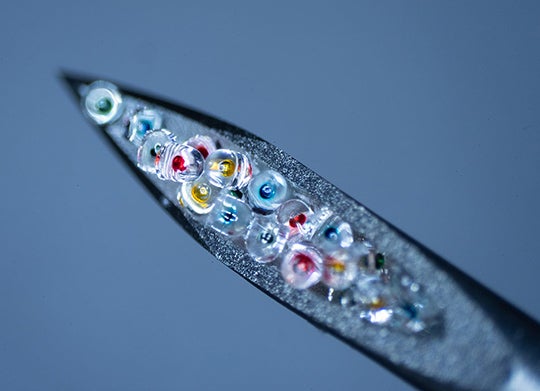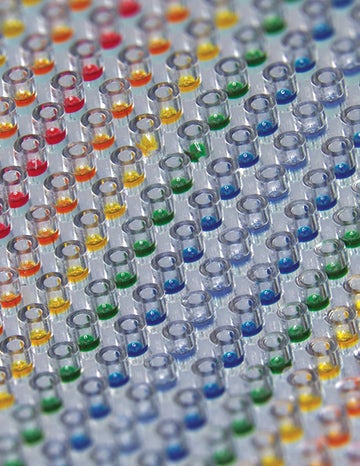Mighty Small Medicine
Tiny cylinders deliver time-released drugs in a single shot.

Summer 2023
By Jade Boyd
Missing crucial doses of medicines and vaccines could become a thing of the past thanks to Rice bioengineers’ next-level technology for sustained drug delivery.
“This is a huge problem in the treatment of chronic disease,” says Kevin McHugh, who recently authored a study of the technology in Advanced Materials. “It’s estimated that 50% of people don’t take their medications correctly. With this, you’d give them one shot, and they’d be all set for the next couple of months.”
Encapsulating medicine in microparticles that dissolve and release drugs over time isn’t a new idea. But McHugh and graduate student Tyler Graf ’24 have used 21st-century methods to develop encapsulation technology that is far more versatile than its forerunners.
Dubbed PULSED, which is short for Particles Uniformly Liquified and Sealed to Encapsulate Drugs, the technology employs high-resolution 3D printing and soft lithography to produce arrays of more than 300 nontoxic, biodegradable cylinders that are small enough to be injected with standard hypodermic needles. The cylinders are made of a polymer called poly lactic-co-glycolic acid that’s widely used in clinical medical treatment.
The idea is to make chemotherapy more effective and reduce its side effects by delivering a prolonged, concentrated dose of the drugs exactly where they’re needed.
McHugh and Graf demonstrated four methods of loading the microcylinders with drugs and showed they could tweak the polymer recipe to vary how quickly the particles dissolved and released the drugs — from as little as 10 days to almost five weeks. They also developed an easy method for sealing the cylinders, a critical step to demonstrate that the technology is both scalable and capable of addressing a major hurdle in time-release drug delivery.

“The thing we’re trying to overcome is ‘first-order release,’” McHugh says, referring to the uneven dosing that’s characteristic with current methods of drug encapsulation. “The common pattern is for a lot of the drug to be released early, on Day 1. And then on Day 10, you might get 10 times less than you got on Day 1,” a situation which is usually therapeutically problematic.
For some patients, it would be ideal to have the same amount of a drug in their systems throughout treatment. McHugh says PULSED can be tailored for that kind of release profile, and it could also be used in other ways — such as treating cancerous tumors with chemotherapies.
“For toxic cancer chemotherapies, you’d love to have the poison concentrated in the tumor and not in the rest of the body,” he says. “People have done that experimentally, injecting soluble drugs into tumors. But then the question is, how long is it going to take for that to diffuse out?
“Our microparticles will stay where you put them,” McHugh says. “The idea is to make chemotherapy more effective and reduce its side effects by delivering a prolonged, concentrated dose of the drugs exactly where they’re needed.”
Kevin McHugh is an assistant professor of bioengineering at Rice.
